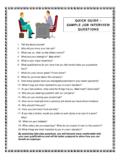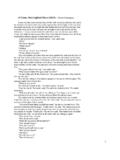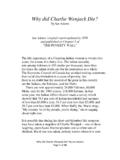Transcription of 229-31: Simple Tests of Hypotheses for the Non ...
1 1 Paper 229-31 Simple Tests of Hypotheses for the Non- statistician : What They Are and Why They Can Go BadArthur L. CarpenterCalifornia Occidental ConsultantsABSTRACTH ypothesis testing is a central component of most statistical analyses. The focal point of these Tests isoften the significance level, but what does this value really mean and how can we effectively use it? Andperhaps more importantly, what are the pitfalls and dangers in its interpretation? As we conduct statisticaltests of Hypotheses , are there other things that we should be doing or looking out for that will aid us in ourdecision making? After years of academic study, professional statisticians will spend additional years gaining a practicalknowledge and experience so that they can correctly conduct and correctly interpret the results ofstatistical Tests .
2 You cannot gain these insights over night, however, this tutorial provides a basicintroduction to the concepts of hypothesis testing, as well as, what you should look for and look out for,while conducting statistical Tests of level, hypothesis test, T-test, Type I error, Type II error, alpha levelINTRODUCTION TO STATISTICAL TESTINGThe point of collecting data is to be able to answer questions. Statistically these questions MUST beframed as Hypotheses and these Hypotheses , in turn, can be tested. The results of the Tests areinterpreted and conclusions are drawn about the original questions. The process seems very straightforward. SAS provides all the processing capability and all we have to provide are the data.
3 The problem,of course, is that the world of testing is not quite that Simple and things can go wrong to the point that itbecomes difficult, if not impossible, to draw valid conclusions. The way that we collect our data and the statement of our questions to be answered, suggest certain Tests of Hypotheses . These Tests are based on rigorously developed and mathematically proventechniques, however to be valid they must be appropriate for the data and the situation. Thisappropriateness defines a set of assumptions, and unless these assumptions are met, distortions areintroduced in what are often unknown and perhaps even unknowable ways. The danger of course is thatthese distortions can cause us to draw incorrect conclusions about our initial a SampleVery often we need to draw conclusions about a population that we are unable to fully measure.
4 Forinstance if we wanted to compare the weights of male and female teenagers, we simply cannot weigh allteenagers in the United States (if for no other reason than they don t hold still long enough). Fortunatelywe can develop statistical estimates about the overall population by taking a subset. This subset of thepopulation is known as a sample, and if it is taken correctly the estimates based on the sample can beapplied to the population. By implication as the size of our sample increases, the reliability of our estimates that are based on thedata will be more accurate. Of course increasing the sample size is often expensive and past some point,TutorialsSUGI31 2can be subject to the laws of diminishing returns. A Typical Value - Using the Mean of a SampleOne of the types of information (statistics) that we often want to determine is a measure of centrality.
5 Oneway to think of centrality is to determine what a typical value of the sample might be. What is the weight ofa typical teenage male? Aside from the fact that there probably are no typical male teenagers, there areseveral statistics that would help us make this estimate. The MEDIAN is the value for which 50 percent ofthose in sample had values above (and below) the median. Another measure of centrality is the MEAN. There are several ways, formulas, that can be used to calculate the mean. The most common of these isknown as the arithmetic mean and it is calculated by dividing the sum of the values by the number formulas for the mean and the median will result in essentially the same number when the distributionof values is fairly symmetrical.
6 Because it has a number of desirable statistical properties, the mean isused for a great many of the common statistical Dispersion - Using the VarianceIf everyone in the population had exactly the same weight, then so too would everyone in the sample, andconsequently the mean would be an exact measure of a typical value. Since the weights of individualsvary, it is likely that the calculated mean of a data sample would be different for different subsets of thepopulation. If all of the individuals have very similar weights, then they will be close to the mean, howeverif the weights fluctuate a great deal, then fewer individuals will have a value close to the typical value. Thus when we measure the mean we also need to know how good the estimate is.
7 The estimate of themean is more precise if the weights are in closer dispersion in the data, and indirectly the precision of the estimate, is measured by the variance. Thisstatistic measures the variability or dispersion in the data. An estimate of this variability will help us toassess how much we can trust our estimate of the mean. Another common measure of dispersion is the standard deviation which is the square root of the variance. The standard deviation is often used as it has the same units as the of the MeanIf you were to take a number of samples, and you calculated an estimate of the mean each time, themean values will themselves have a distribution. According to the Central Limit Theorem the resultingdistribution of values can be described using the normal distribution.
8 This is also sometimes referred toas the Bell Shaped Curve . This property of the mean and the characteristics of the Normal distribution combine to give the statisticiana number of very nice properties that are used in many of the parametric statistical Tests that arecommonly describing a sample (or a population) is rarely sufficient. Usually we need to ask questions of thedata is the mean weight of males different from the mean weight of females. In order to ask thisquestion statistically we need to rephrase it as an hypothesis. It is this hypothesis that becomes central tothe testing that is discussed Hypotheses to be tested determine everything from the experimental design to the types of statisticalanalyses that are to be utilized.
9 In a well designed study the researcher first determines the question ofinterest, phrases it as an hypothesis, and then determines how the data are to be collected and too many researchers use the PARC method (Planning After Research Completed) fordesigning their experiment. They first collect the data and then try to determine what questions can beasked. The utility of this method is best described by spelling its name 3 The NULL hypothesis ( Ho) is best stated in terms of equalities things are not different, for instance:The mean weight of the males in the study is not different from that of the Alternative hypothesis (HA) becomes the secondary hypothesis, if the null hypothesis is disproved.:The mean weight of the males in the study is greater than that of the statistical Tests calculate significance levels, and it is these significance levels which are used as ameasure of the validity of the Hypotheses .
10 The significance level, which is also called the alpha level , isoften indicated with Greek letter alpha, ". If the significance level is small then it is unlikely that the nullhypothesis can be accepted. Since our statistics are based on a sample, we cannot be assured that our particular sample fullyrepresents that of the population. This means that we may reject a null hypothesis based on our particularsample, when in fact the hypothesis was true. In fact the significance level tells us the probability ofmaking that mistake. By tradition most researchers will reject the null hypothesis when the significancelevel is below .05 (they are willing to accept a 5% risk of making the mistake of rejecting a true nullhypothesis).


















